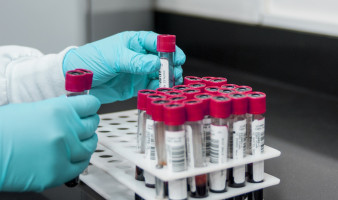
A small portion of adults in remission from a deadly blood cancer had persisting mutations that were detected, which predicted their risk of death from having the cancer return
Researchers at the National Institutes of Health show the benefits of screening adult patients in remission from acute myeloid leukaemia (AML) for residual disease before receiving a bone marrow transplant.
The findings, published in JAMA, support ongoing research aimed at developing precision medicine and personalised post-transplant care for these patients.
About 20,000 adults in the United States are diagnosed each year with AML, a deadly blood cancer, and about one in three live past five years.
A bone marrow transplant, which replaces unhealthy blood-forming cells with healthy cells from a donor, often improves these chances.
However, research has shown that lingering traces of leukaemia can make a transplant less effective.
Researchers in the current study wanted to show that screening patients in remission for evidence of low levels of leukaemia using standardised genetic testing could better predict their three-year risks for relapse and survival.
To do that, they used ultra-deep DNA sequencing technology to screen blood samples from 1,075 adults in remission from AML.
All were preparing to have a bone marrow transplant.
The study samples were provided through donations to the Center for International Blood and Marrow Transplant Research.
After screening adults with variants commonly associated with AML, researchers showed that the two most common mutations in AML – NPM1 and FLT3-ITD – could be used to track residual leukaemia.
Among 822 adults with these variants detectable at initial diagnosis, 142 adults – about 1 in 6 – were found to still have residual traces of these mutations after therapy despite being classified as in remission.
The researchers found the outcomes for these patients striking.
Nearly 70% of patients with the lingering NPM1 and FLT3-ITD mutations relapsed and just 39% survived after three years.
In comparison only 21% of adults without this evidence of trace leukaemia relapsed after three years and 63% survived.
“If I’m one of six people waiting in a doctor’s office and we’re all being told we’re going in for a transplant and we’ve got the same risk, I want to know if I’m actually one of those five who has a 20% chance of relapse or if I am the one with a 70% chance of relapse,” said study lead Christopher S Hourigan, MD, D Phil, senior investigator and chief of the Laboratory of Myeloid Malignancies, part of the National Heart, Lung, and Blood Institute’s (NHLBI) Intramural Program.
“Having this increased risk for relapse may not impact a person’s decision about having a bone marrow transplant, but it could influence their next steps in care,” Hourigan said. “For that one person out of six, the transplant often isn’t going to be enough. Other options might include also enrolling in a clinical research trial or considering additional or different therapies.”
“This study confirms prior research and provides new important data showing why testing for residual disease before a transplant is critical,” said Rear Admiral Richard Childs, MD, clinical director and acting scientific director of NHLBI. “This information can also empower physicians to tailor transplant strategies, including considering different pre-transplant conditioning regimens and chemotherapies, to reduce an AML patient’s risk for relapse and improve their long-term chance for survival.”
In their analysis, the researchers also observed that adults with persistent mutations, but who were younger than age 60 and received higher doses of chemotherapy and/or radiotherapy as part of their transplant preparation, were more likely to remain cancer free after three years than those receiving lower doses.
They also found that adults who didn’t receive stronger treatment before the transplant, which is now recommended as part of clinical guidelines, did better when this lower-dose therapy included a chemotherapy drug melphalan.
However, more research is needed to evaluate these potential benefits and of other treatments, including targeted therapy for the FLT3-ITD mutation.
“Finding bold and innovative approaches, including precision therapy for AML, is essential to the Biden Administration’s goal to cut the death rate from cancer in half within the next 25 years,” said James H Doroshow, MD, Deputy Director for Clinical and Translational Research at the National Cancer Institute.
AML accounts for 1% of all new cancer cases, and adults ages 65 and older are more likely to receive a diagnosis.
We are an independent charity and are not backed by a large company or society. We raise every penny ourselves to improve the standards of cancer care through education. You can help us continue our work to address inequalities in cancer care by making a donation.
Any donation, however small, contributes directly towards the costs of creating and sharing free oncology education.
Together we can get better outcomes for patients by tackling global inequalities in access to the results of cancer research.
Thank you for your support.